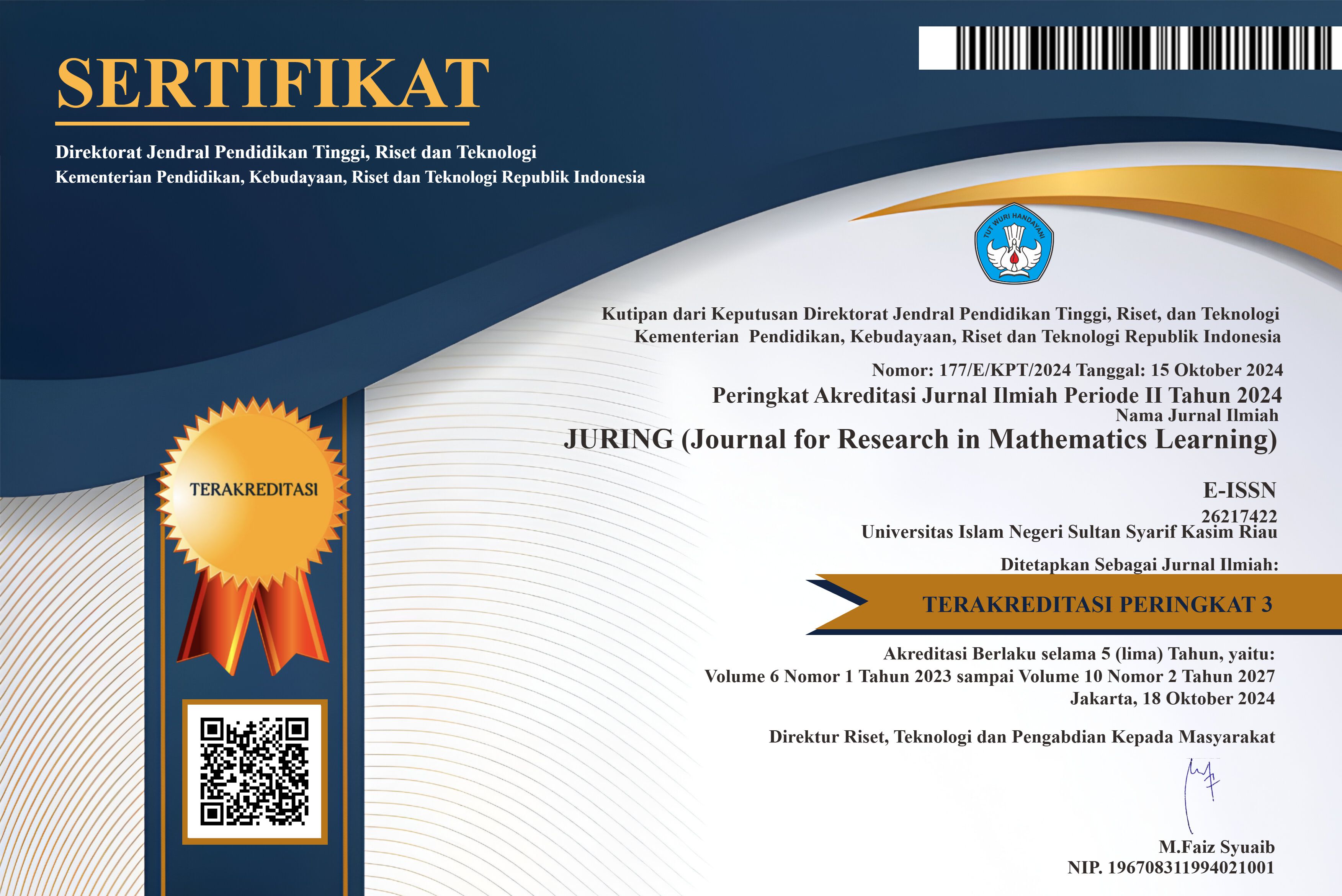Membentuk Sketsa Grafik Mahasiswa Tadris Matematika: Menggunakan Instrument Penalaran Kovariasonal Thompson
Abstract
Full Text:
PDFReferences
Ali, S., Lulseged, S., & Medhin, G. (2018). EMJ series on statistics and methods part IV: Presenting and summarizing data using graphical tools. Ethiopian Medical Journal, 56(4), 389–396. https://doi.org/https://emjema.org/index.php/EMJ/article/view/1141
Banu, D. F., Kousalya, P. T., Varsha, K., Prashanth, C. K.,
Madhumohan, P., & Meivel, S. (2024). Research analysis of data exploration and visualization dashboard using data science. In Multidisciplinary Applications of AI Robotics and Autonomous Systems (pp. 206–217). https://doi.org/10.4018/979-8-3693-5767-5.ch014
Carlson, M., Jacobs, S., Coe, E., Larsen, S., & Hsu, E. (2002). Applying covariational reasoning while modeling dynamic events: A framework and a study. Journal for Research in Mathematics Education, 33(5), 352–378. https://doi.org/10.2307/4149958
Carlson, M. P. (1995). A cross-sectional investigation of the development of the function concept. University of Kansas.
Confrey, J., & Smith, E. (1994). Exponential functions, rates of change, and the multiplicative unit. Educational Studies in Mathematics, 26, 135–164.
El Morr, C., Jammal, M., Ali-Hassan, H., & El-Hallak, W. (2022). Data Visualization. In International Series in Operations Research and Management Science (Vol. 334, pp. 165–193). https://doi.org/10.1007/978-3-031-16990-8_5
Gantt, A. L., Paoletti, T., & Corven, J. (2023). Exploring the prevalence of Covariational reasoning across Mathematics and Science using TIMSS 2011 Assessment items. International Journal of Science and Mathematics Education, 21(8), 2349–2373.
Gupta, A., Khodwal, A., & Pal, N. (2022). VacoPie: Visualizing Variance and Covariance Information onto Categorical Distribution of Data. ACM International Conference Proceeding Series, 324–325. https://doi.org/10.1145/3493700.3493763
Habre, S. (2017). Students’ challenges with polar functions: covariational reasoning and plotting in the polar coordinate system. International Journal of Mathematical Education in Science and Technology, 48(1), 48–66. https://doi.org/10.1080/0020739X.2016.1220027
Harini, N. V. (2019). Capturing students’ covariational reasoning levels while solving integrals problem. Journal of Physics: Conference Series, 1157(4). https://doi.org/10.1088/1742-6596/1157/4/042048
Islam, M., & Jin, S. (2019). An Overview of Data Visualization. Nternational Conference on Information Science and Communications Technologies (ICISCT), 1–7. https://doi.org/doi: 10.1109/ICISCT47635.2019.9012031.
Johnson, H. L., McClintock, E. D., & Gardner, A. (2020). Opportunities for Reasoning: Digital Task Design to Promote Students’ Conceptions of Graphs as Representing Relationships between Quantities. Digital Experiences in Mathematics Education, 6(3), 340–366. https://doi.org/10.1007/s40751-020-00061-9
Kertil, M. (2020). Covariational reasoning of prospective mathematics teachers: How do dynamic animations affect? Turkish Journal of Computer and Mathematics Education (TURCOMAT), 11(2), 312–342. https://doi.org/DOI: 10.16949/turkbilmat.652481
Kertil, M., Erbas, A. K., & Cetinkaya, B. (2019). Developing prospective teachers’ covariational reasoning through a model development sequence. Mathematical Thinking and Learning, 21(3), 207–233. https://doi.org/10.1080/10986065.2019.1576001
Kiernan, N. A., Manches, A., & Seery, M. K. (2024). Resources for reasoning of chemistry concepts: multimodal molecular geometry†. Chemistry Education Research and Practice. https://doi.org/10.1039/d3rp00186e
Lyman, R. L. (2015). Graphing Evolutionary Patternin Stone Tools to Reveal Evolutionary Process. In N. Goodale & W. Andrefsky, Jr (Eds.), Lithic Technological Systems and Evolutionary Theory. Cambridge: Cambridge University Press.
Moore, K. C., Liang, B., Stevens, I. E., Tasova, H. I., Paoletti, T., & Ying, Y. (2020). A quantitative reasoning framing of concept construction. Proceedings of the Annual Conference on Research in Undergraduate Mathematics Education.
Moore, K. C., Paoletti, T., & Musgrave, S. (2013). Covariational reasoning and invariance among coordinate systems. The Journal of Mathematical Behavior, 32(3), 461–473. https://doi.org/https://doi.org/10.1016/j.jmathb.2013.05.002
Ng, K. H., & Peh, W. C. G. (2009). Preparing effective illustrations. Part 1: Graphs. Singapore Medical Journal, 50(3), 245–249.
Palha, S., Bouwer, A., Bredeweg, B., & Keulen, S. (2020). Self-construction and interactive simulations to support the learning of drawing graphs and reasoning in mathematics. Intelligent Tutoring Systems: 16th International Conference, ITS 2020, Athens, Greece, June 8–12, 2020, Proceedings 16, 364–370. Springer.
Paoletti, T. (2020). Reasoning about relationships between quantities to reorganize inverse function meanings: The case of Arya. Journal of Mathematical Behavior, 57. https://doi.org/10.1016/j.jmathb.2019.100741
Paoletti, T., Gantt, A. L., & Corven, J. (2023). A Local Instruction Theory for Emergent Graphical Shape Thinking: A Middle School Case Study. Journal for Research in Mathematics Education, 54(3), 202–224. https://doi.org/10.5951/jresematheduc-2021-0066
Paoletti, T., Gantt, A. L., & Vishnubhotla, M. (2022). Constructing a system of covariational relationships: two contrasting cases. Educational Studies in Mathematics, 110(3), 413–433.
Saldanha, L. A., & Thompson, P. W. (1998). Re-thinking Covariation from a Quantitative Perspective: Simultaneous Continuous Variation. In Proceedings of the Annual Meeting of the Psychology of Mathematics Education - North America (Vol. 1).
Taylor, H. A., Burte, H., & Renshaw, K. T. (2023). Connecting spatial thinking to STEM learning through visualizations. Nature Reviews Psychology, 2(10), 637–653. https://doi.org/10.1038/s44159-023-00224-6
Thompson, P. W. (1994). Images of rate and operational understanding of the fundamental theorem of calculus. Educational Studies in Mathematics, 26(2), 229–274.
Thompson, P. W., Hatfield, N. J., Yoon, H., Joshua, S., & Byerley, C. (2017). Covariational reasoning among US and South Korean secondary mathematics teachers. The Journal of Mathematical Behavior, 48, 95–111.
DOI: http://dx.doi.org/10.24014/juring.v7i3.27941
Refbacks
- There are currently no refbacks.
Juring (Journal for Research in Mathematics Learning)
Universitas Islam Negeri Sultan Syarif Kasim Riau
Indexed by:













